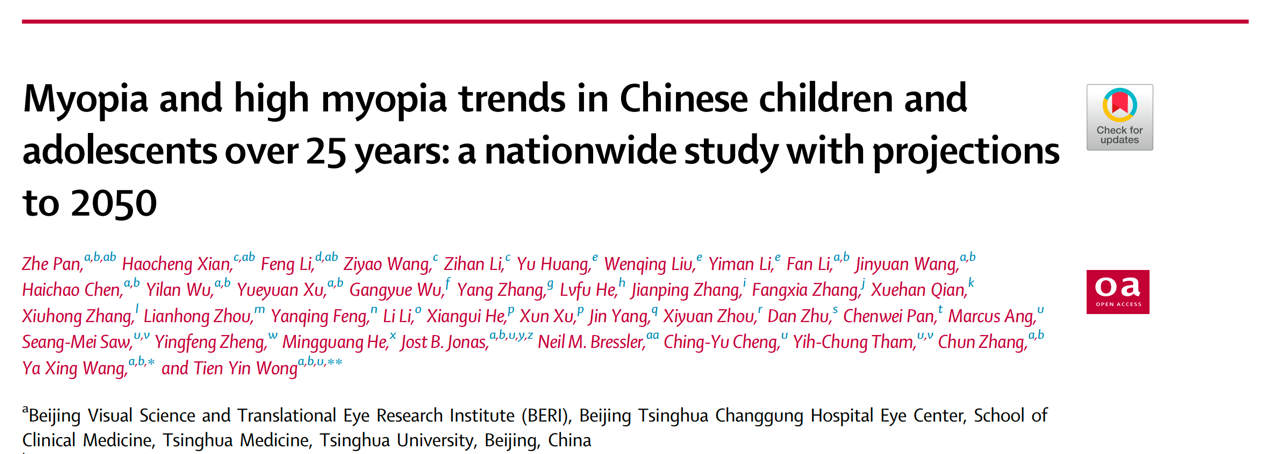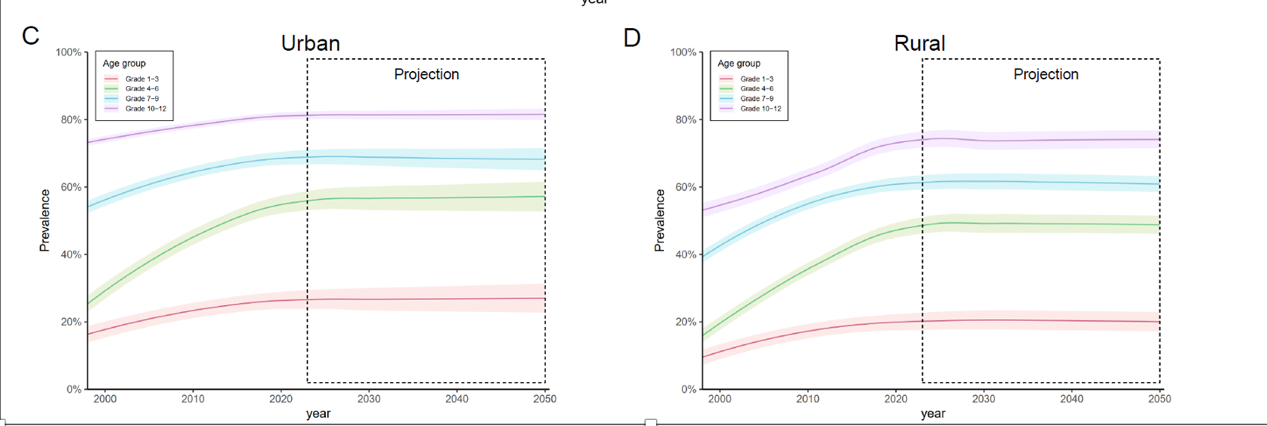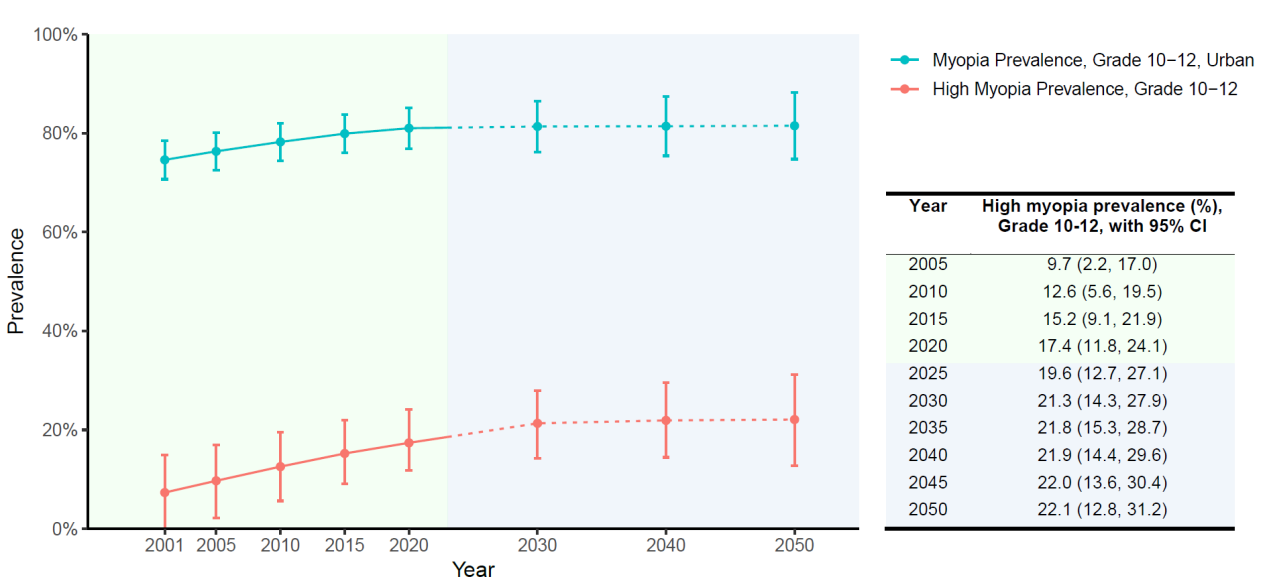
(Translated By YU.Y.C.)Myopia has become a major public health challenge of global concern. Research shows that by 2050, the number of myopic people worldwide is expected to reach 4.8 billion, accounting for about half of the global population. Among them, the situation in East Asia is particularly severe, with the myopia rate among high school students in China approaching 80%. With the increase in the number of patients, blinding eye diseases related to high myopia have also risen significantly, such as retinal detachment, macular degeneration and glaucoma, which have become one of the main causes of blindness.
Recently, the Ophthalmology Center of Beijing Tsinghua Changgung Hospital and Beijing Visual Science and Translational Eye Research Institute(BERI), in collaboration with several domestic institutions, conducted the largest sample size, longest time span, and widest coverage epidemiological study on myopia among Chinese children and adolescents to date. By tracking the changes in the disease over a period of 25 years, they used scientific data to predict future development trends.

Trends and predictions of myopia prevalence in Urban and rural areas in four age groups

Trend and Prediction of High Myopia Prevalence (Red) and Myopia Prevalence in Cities (Grades 10-12) (Blue)
High myopia is the "invisible killer" of vision health. It not only brings about blurred vision and frequent glasses changes, but more seriously, it increases the risk of irreversible retinal and optic nerve diseases, such as a significant increase in the risk of retinal detachment. The incidences of macular degeneration, retinal holes and hemorrhage have soared. The risk of high myopic glaucoma and posterior scleral staphyloma is increased. The probability of moderate to severe permanent loss of visual function or even blindness is greatly increased, especially if high myopia develops during adolescence, it will affect lifelong vision quality, learning ability, career choice and quality of life.
Studies show that the prevalence of high myopia among teenagers aged 16-18 is expected to rise from 7.3% in 2001 to 22.1% in 2050, meaning that almost one in every five high school students will have high myopia. Although the overall level of myopia has reached a plateau (stabilizing in urban areas since 2006 and in rural areas since 2013, and the national level is expected to stabilize around 2030), the growth trend of high myopia has not yet peaked and is expected to continue to rise until it reaches its peak around 2040. The risk will continue to rise before 2050. The rate of high myopia among 16-18-year-olds in urban areas will increase from 18.2% in 2022 to 22.1% in 2050. Although rural areas have a relatively low starting point, they have grown rapidly and the gap between urban and rural areas has narrowed significantly. If no effective intervention is taken, China will enter a high-incidence period of blinding eye diseases mainly characterized by high myopia in the next two or three decades.
This study, for the first time, comprehensively reveals the overall trend of myopia and high myopia among children and adolescents in China with authoritative big data. It provides important scientific basis for the country to formulate policies for the prevention and control of myopia among children and adolescents, allocate educational resources in urban and rural areas, and promote outdoor activities. It also reminds the society that it is necessary to intervene in the progression of high myopia as early as possible to reduce the risk of irreversible blindness caused by retinal diseases.

Normal fundus (A) and manifestations of fundus complications related to high myopia.
(A) Normal fundus structure
(B) High myopia combined with macular degeneration
(C, D) Choroidal atrophy, posterior scleral staphyloma and macular schisis caused by high myopia
The study's name is Myopia and high myopia trends in Chinese children and adolescents over 25 years: a nationwide study with projections to 2050, and ita was officially published on The Lancet Regional Health - Western Pacific,the international authoritative medical journal.
Wang Yaxing, an associate chief physician at the Ophthalmology Center of Beijing Tsinghua Changgung Hospital, and Tien Yin Wong, the vice provost and dean of the School of Medicine at Tsinghua University and a renowned expert at the Ophthalmology Center of Beijing Tsinghua Changgung Hospital, co-authored the corresponding authors. Pan Zhe, a resident physician at the Ophthalmology Center of Beijing Tsinghua Changgung Hospital, Xian Haocheng, a doctor from Peking University Third Hospital, and Li Feng, a professor at the Guanghua School of Management of Peking University, co-authored the first authors.
The research was conducted by Zhang Chun, the deputy director of the Ophthalmology Center of Tsinghua Changgung Hospital in Beijing, Dr. Wang Ziyao from Peking University Third Hospital, Professors Seang-Mei Saw and Marcus Ang from the National University of Singapore, and Professor Neil M. Bressler from Johns Hopkins University in the United States, Professor Jost B. Jonas from Heidelberg University in Germany, fully demonstrates the scientific research advantages of multi-disciplinary, multi-center and international collaboration.
